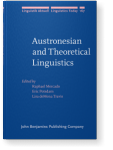Marc Brunelle
List of John Benjamins publications for which Marc Brunelle plays a role.
2020 Chapter 2. The loss of affixation in Cham: Contact, internal drift and the limits of linguistic history Austronesian Undressed: How and why languages become isolating, Gil, David and Antoinette Schapper (eds.), pp. 97–118 | Chapter
Chamic languages have been spoken in Central Vietnam since about 600 AD. While Classical Cham (9th–15th centuries), had already lost a significant proportion of its Austronesian affixation, it also borrowed new affixes from Mon-Khmer. Modern Cham (16th–19th centuries) underwent another wave of… read more
2019 Chapter 2. Intonation in southern Vietnamese interrogative sentences Interdisciplinary Perspectives on Vietnamese Linguistics, Duffield, Nigel, Trang Phan and Tue Trinh (eds.), pp. 9–30 | Chapter
This study looks at the acoustic cues that characterize the intonation of questions in southern Vietnamese. We find a raised f0 height and a rising contour in a third of interrogatives, but – with the exception of alternative (and some open) questions – we argue that these properties cannot… read more
2012 Phonologically-constrained change: The role of the foot in monosyllabization and rhythmic shifts in Mainland Southeast Asia Diachronica 29:4, pp. 411–433 | Article
Changes in word shapes in Mainland Southeast Asia are usually attributed to contact-induced typological convergence. However, little attention has been paid to the role of structural constraints in defining paths of change. In this paper, we describe two distributional gaps in paths of word shape… read more
2010 The role of larynx height in the Javanese tense ~ lax stop contrast Austronesian and Theoretical Linguistics, Mercado, Raphael, Eric Potsdam and Lisa deMena Travis (eds.), pp. 7–24 | Article
Javanese has a phonemic contrast between two series of stops. Tense stops are modern reflexes of Proto-Austronesian voiceless stops while lax stops correspond to former voiced stops. This complex contrast includes acoustic properties such as pitch, voice quality, vowel quality and VOT. Although… read more
2009 2. Diglossia and monosyllabization in Eastern Cham: A sociolinguistic study Variation in Indigenous Minority Languages, Stanford, James N. and Dennis R. Preston (eds.), pp. 47–75 | Article
In Eastern Cham, the modern reflexes of Classical Cham disyllables exhibit variation between sesquisyllabic and monosyllabic word shapes, which suggests that the language is becoming increasingly monosyllabic. This apparent change in progress has been attributed to contact with monosyllabic… read more




